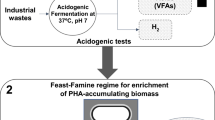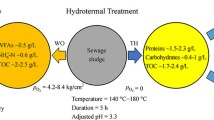Abstract
In this investigation, the effect of pH (4.0–11.0) on waste-activated sludge (WAS) hydrolysis and acidification in the presence of a biosurfactant rhamnolipid (RL) were studied. The results showed that the hydrolysis and acidification of WAS in the presence of RL at alkaline pH values were more efficient than that at acidic and near-neutral pH values. After 6 h of hydrolysis, the soluble protein and carbohydrate were 1,654.7 and 675.9 mg/L (pH 11.0), and 825.6 and 376.0 mg/L (pH 7.0), whereas the values were only 315.0 and 84.0 mg/L at pH 4.0 and 164.1 and 32.0 mg/L for the blank, respectively. After 2 or 3 days of fermentation, the accumulated short-chain fatty acids (SCFAs) reached the highest and then decreased with a further increase in time at all investigated pH values. The analysis of SCFA compositions showed that acetic, propionic, and iso-valeric acids were the three main products at any pH value. A higher pH contributed to a greater proportion of acetic acid and a lesser proportion of iso-valeric acid; a lower pH resulted in a greater proportion of iso-valeric and lesser proportion of acetic acid in the initial fermentation. The proportions of acetic acid for the system with biosurfactant RL addition were 16.65, 36.33, and 62.94 %, respectively, at pH 4.0, 7.0, and 11.0 after 1 day. Correspondingly, the proportions were 40.34, 12.60, and 11.01 % for iso-valeric acid.






Similar content being viewed by others
References
Champion JT, Gilkey JC, Lamparski HL, Retterer J, Miller RM (1995) Electron microscopy of rhamnolipid (biosurfactant) morphology: effect of pH, cadmium, and octadecane. J Colloid Interface Sci 170:569–574
Chen YG, Jiang S, Yuan HY, Zhou Q, Gu GW (2007) Hydrolysis and acidification of waste activated sludge at different pHs. Water Res 41:683–689
Eastman JA (1977) Solubilisation of organic carbon during the acid phase of anaerobic digestion. PhD thesis, University of Washington
Eastman JA, Ferguson JF (1981) Solubilization of particulate organic carbon during the acid phase of anaerobic digestion. J Water Pollut Control Fed 53:352–366
Eaton AD, Clesceri LS, Rice EW, Greenberg AE, Franson MAH (2005) Standard methods for the examination of water and wastewater, 21st edn. American Public Health Association, Washington, DC
Jain DK, Lee H, Trevors JT (1992) Effect of addition of Pseudomonas aeruginosa UG2 inocula or biosurfactants on biodegradation of selected hydrocarbons in soil. J Ind Microbiol Biotechnol 10:87–93
Jiang S, Chen YG, Zhou Q (2007a) Effect of sodium dodecyl sulfate on waste activated sludge hydrolysis and acidification. Chem Eng J 132:311–317
Jiang S, Chen YG, Zhou Q, Gu GW (2007b) Biological short-chain fatty acids (SCFAs) production from waste-activated sludge affected by surfactant. Water Res 41:3112–3120
Kang XR, Zhang GM, Chen L, Dong WY, Tian WD (2011) Effect of initial pH adjustment on hydrolysis and acidification of sludge by ultrasonic pretreatment. Ind Chem Eng Res 50:12372–12378
Li X, Chen H, Hu LF, Yu L, Chen YG, Gu GW (2011) Pilot-scale waste activated sludge alkaline fermentation, fermentation liquid separation, and application of fermentation liquid to improve biological nutrient removal. Environ Sci Technol 45:1834–1839
Liu J, Yuan XZ, Zeng GM, Shi JG, Chen S (2006) Effect of biosurfactant on cellulase and xylanases production by Trichoderma viride in solid substrate fermentation. Process Biochem 41:2347–2351
Low EW, Chase HA, Milner MG, Curtis TP (2000) Uncoupling of metabolism to reduce biomass production in the activated sludge process. Water Res 34:3204–3212
Luo K, Yang Q, Yu J, Li XM, Yang GJ, Xie BX, Yang F, Zheng W, Zeng GM (2011) Combined effect of sodium dodecyl sulfate and enzyme on waste activated sludge hydrolysis and acidification. Bioresour Technol 102:7103–7110
Mayer AS, Zhong L, Pope GA (1999) Measurement of mass-transfer rates for surfactant-enhanced solubilization of nonaqueous phase liquids. Environ Sci Technol 33:2965–2972
McInerney MJ (1988) Anaerobic hydrolysis and fermentation of fats and proteins. In: Zehnder AJB (ed) Biology of anaerobicmicroorganisms. Wiley, New York, pp 373–416
Min B, Logan BE (2004) Continuous electricity generation from domestic wastewater and organic substrates in a flat plate microbial fuel cell. Environ Sci Technol 38:5809–5814
Miron Y, Zeeman G, Van Lier JB, Lettinga G (2000) The role of sludge retention time in the hydrolysis and acidification of lipids, carbohydrates and proteins during digestion of primary sludge in CSTR systems. Water Res 34:1705–1713
Mossakowska A, Hellström BG, Hultman B (1998) Strategies for sludge handling in the Stockholm region. Water Sci Technol 38:111–118
Mulligan CN (2005) Environmental applications for biosurfactants. Environ Pollut 133:183–198
Nah IW, Kang YW, Hwang KY, Song WK (2000) Mechanical pretreatment of waste activated sludge for anaerobic digestion process. Water Res 34:2362–2368
Phothilangka P, Schoen MA, Huber M, Luchetta P, Winkler T, Wett B (2008) Prediction of thermal hydrolysis pretreatment on anaerobic digestion of waste activated sludge. Water Sci Technol 58:1467–1473
Sikkema J, de Bont JAM, Poolman B (1995) Mechanisms of membrane toxicity of hydrocarbons. Microbiol Rev 59:201–222
Sotirova A, Spasova D, Vasileva-Tonkova E, Galabova D (2009) Effects of rhamnolipid-biosurfactant on cell surface of Pseudomonas aeruginosa. Microbiol Res 164:297–303
Suthar S (2009) Vermistabilization of municipal sewage sludge amended with sugarcane trash using epigeic Eisenia fetida (Oligochaeta). J Hazard Mater 163:199–206
Suwannakham S, Yang ST (2005) Enhanced propionic acid fermentation by Propionibacterium acidipropionici mutant obtained by adaptation in a fibrous-bed bioreactor. Biotechnol Bioeng 91:325–337
Tanaka S, Kamiyama K (2002) Thermochemical pretreatment in the anaerobic digestion of waste activated sludge. Water Sci Technol 46:173–179
Vinson PK, Bellare JR, Davis HT, Miller GW, Scriven LE (1991) Direct imaging of surfactant micelles, vesicles, discs, and ripple phase structures by cryo-transmission electron microscopy. J Colloid Interface Sci 142:74–91
Vlyssides AG, Karlis PK (2004) Thermal-alkaline solubilization of waste activated sludge as a pre-treatment stage for anaerobic digestion. Bioresource Technol 91:201–206
Wang CC, Chang CW, Chu CP, Lee DJ, Chang BV, Liao CS (2003) Producing hydrogen from wastewater sludge by Clostridium bifermentans. J Biotechnol 102:83–92
Wei YS, Van Houten RT, Borger AR, Eikelboom DH, Fan YB (2003) Minimization of excess sludge production for biological wastewater treatment. Water Res 37:4453–4467
Wingender J, Neu TR, Flemming HC (1999) Microbial extracellular polymeric substances: characterisation, structure and function. Springer, Berlin, 123 pp
Yan Y, Feng L, Zhang C, Wisniewski C, Zhou Q (2010) Ultrasonic enhancement of waste activated sludge hydrolysis and volatile fatty acids accumulation at pH 10.0. Water Res 44:3329–3336
Yang Q, Luo K, Li XM, Wang DB, Zheng W, Zeng GM, Liu JJ (2010) Enhanced efficiency of biological excess sludge hydrolysis under anaerobic digestion by additional enzymes. Bioresour Technol 101:2924–2930
Zhang YM, Miller RM (1992) Enhanced octadecane dispersion and biodegradation by a Pseudomonas rhamnolipid surfactant (biosurfactant). Appl Environ Microbiol 58:3276–3282
Zhang QZ, He GF, Wang J, Cai WM, Xu YT (2009a) Mechanisms of the stimulatory effects of rhamnolipid biosurfactant on rice straw hydrolysis. Appl Energy 86:233–237
Zhang P, Chen YG, Zhou Q (2009b) Waste activated sludge hydrolysis and short-chain fatty acids accumulation under mesophilic and thermophilic conditions: effect of pH. Water Res 43:3735–3742
Acknowledgments
This research was financially supported by the project of National Natural Science Foundation of China (no. 51078128), International Science & Technology Cooperation Program of China (no. 2011DFA90740), Planned Science and Technology Project of Hunan Province, China (no. 2011SK3215) and Shanghai Tongji Gao Tingyao Environmental Science & Technology Development Foundation (STGEF).
Author information
Authors and Affiliations
Corresponding author
Rights and permissions
About this article
Cite this article
Luo, K., Ye, Q., Yi, X. et al. Hydrolysis and acidification of waste-activated sludge in the presence of biosurfactant rhamnolipid: effect of pH. Appl Microbiol Biotechnol 97, 5597–5604 (2013). https://doi.org/10.1007/s00253-012-4378-4
Received:
Revised:
Accepted:
Published:
Issue Date:
DOI: https://doi.org/10.1007/s00253-012-4378-4




